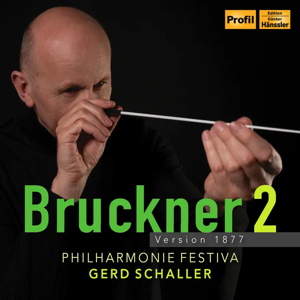
Anton Bruckner (1824-1896)
Symphony No. 2 in C minor (final version 1877)
Philharmonie Festiva/Gerd Schaller
rec. live, 1 October 2023, Abteikirche, Ebrach, Germany
Profil PH23085 [55]
Gerd Schaller previously performed and recorded the earlier, 1872, version of the Second Symphony – see my 2017 review of the box set of Symphonies 1, 2 and 3. It is a work of great contrasts, exhibiting an unprecedented proliferation of themes and typically underwent a number of revisions until just before the first performance of this 1877 version.
I have now heard so many of Schaller’s performances both live and recorded, that I have come to take for granted the excellence of the spacious sound, sensitive conducting and flawless execution sustained throughout his ongoing BRUCKNER2024 project; particular praise goes to the horn section here, which has so many solo passages. There is an urgency to the opening which augurs well for the dynamism of this reading; it then relaxes into a brisk Andante which still retains plenty of momentum and in turn segues seamlessly into the wide-leaping, almost galumphing, intervals of the third theme. In general, speeds are on the fast side and Schaller presses harder than in his recording of the 1872 version, which suits the ever-shifting, mercurial nature of this music – with the exception of the Scherzo, of which the martial outer sections are slower and weightier than usual and the Trio earthier and more “agricultural” in character – and it is, of course, here placed third in the sequence of movements rather than second as in the 1872 version. The coda is emphatic. The Adagio is nobly played but retains more of a sense of urgency than that of Schaller’s earlier recording, consistent with his more driven approach – but he still finds great tenderness in the conclusion with its solo violin song and final benison. The opening of the finale is highly dramatic; the orchestral playing is fluent and sonorous. The paciness helps keep the disparate material unified and tension levels are maintained at a high level all through the last five minutes to the grand peroration.
This is a highly enjoyable, entirely consistent and coherent account, one to sit alongside Giulini’s excellent 1974 studio recording with the Vienna Symphony Orchestra.
Ralph Moore
Help us financially by purchasing from

















